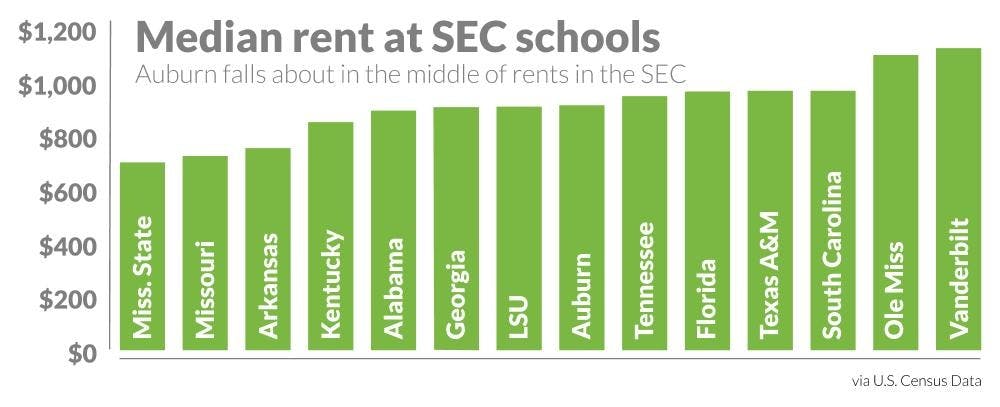The frantic hunt for housing is a cycle many students know too well.
Which complexes still have vacancies? How far away is it? Who needs a roommate? Would it be cheaper to live on campus? Is there even space on campus? How many bedrooms are there?
And perhaps most important of all: How much is the rent?
It’s no secret that Auburn’s student housing market is going through some growing pains. A clamoring demand has pushed the average vacancy rate to below 3 percent, according to the landmark Danter Report on student housing prepared for the city in 2018.Those rock-bottom vacancy rates mean the housing supply is not meeting the demand, according to the report.
That has consequences — namely, higher rent prices.
From March 2015 to May 2018, average rents for off-campus student housing shot up by more than 25 percent, The Plainsman reported in October 2018. That’s an average of about 8 percent per year, ending with a median rent for a 2-bedroom apartment at $914 in 2018.
Those prices put Auburn right in the middle of the pack compared to other SEC schools, according to data from the U.S. Census’ American Community Survey and the rent price database RentCafe.
Out of all 14 schools in the SEC, Auburn came in as the eighth most expensive place to find student housing. The most expensive area was Nashville, Tennessee, home of Vanderbilt University, with a median rent of $1,126 for a 2-bedroom apartment. The cheapest was Starkville, Mississippi, home of Mississippi State University, with a median rent of about $700 for a 2-bedroom apartment.
Auburn’s rent is expensive for the region as well. Surrounding Alabama and Georgia cities, such as Columbus, LaGrange, Montgomery and Opelika, all had cheaper median rents than Auburn. Birmingham was more costly, with a median 2-bedroom apartment rent of $946 compared to Auburn’s $914.
On-campus student housing was cheaper, with the cheapest option coming in at $3,060 per semester, which is $612 a month, at the Hill Residence Halls. However, Auburn only has enough beds on-campus to house 4,725 of its over 30,000 students, according to the Danter Report.
Navigating the maze of prices and places can be a major task for students. Aaron Carpenter, graduate student in public administration, said he began searching for housing a year before actually moving to the city.
“I didn’t want a roommate, and it was difficult finding something, and a lot of stuff was too expensive,” he said.
Carpenter said prices in Auburn were higher than in Dothan, Alabama, where he used to live, although he said part of that may be because some students have lofty expectations for apartment amenities.
“It wasn’t hard to hear about hardwood floors and granite countertops in listings,” he said.
Carpenter has been able to stay in the same rental since moving to Auburn, but others have repeated the search many times.
Aura Reyna, senior in mechanical engineering, said rent increases or roommate issues have pushed her to make stressful moves several times.
She said the overall price of rent did concern her at times, but compared to her hometown of Houston, Texas, prices in Auburn seemed downright reasonable.
“At Auburn you can find a really nice apartment,” Reyna said. “All of my friends who are from the South, a lot say, ‘I’m not willing to pay more than $600 for a good apartment,’ and for them, that’s reasonable. That’s what their parents had at Auburn, they only paid $250 for rent ever, why would we pay more than that?”
But prices like those are long gone, she concluded.
“Times have changed and apartments like to steal money from students,” Reyna said.
High rents can lead to housing instability, forcing students to take outside jobs to make ends meet and hurting their academics, according to a 2016 report from the Department of Housing and Urban Development.
“Many students — disproportionately low-income students — cope (with high rents) by enrolling part-time or working long hours at jobs, which can make it more difficult for them to complete their education,” the report says.
In the 2018 National Student Engagement Survey, six percent of Auburn students said there was at least one instance where they did not pay their full housing or utility bill in the last year.
High housing prices may even affect a school’s recruitment base, as lower-income students can face a “sticker shock” that deters them from even bothering to apply, according to a different report from HUD in 2015.
The City of Auburn is wading through the issue, which has proven particularly thorny. Luxury high-rise student housing complexes brought criticism from some who thought the towering buildings damaged the quality of Auburn’s downtown.
Small houses, designed to look like single-family homes but meant to house students, brought their own controversies. Known as academic detached dwelling units, these have raised fears of gentrification as these ADDUs threaten to encroach into traditionally minority and residential neighborhoods.
Auburn Mayor Ron Anders convened a task force to search for student housing solutions, which has yet to meet.
The city is still considering ways to regulate ADDUs, and it may well need to, as the Danter Report anticipates the city will need more beds over the years to absorb an ever-increasing demand for student-centered housing.
Do you like this story? The Plainsman doesn't accept money from tuition or student fees, and we don't charge a subscription fee. But you can donate to support The Plainsman.





